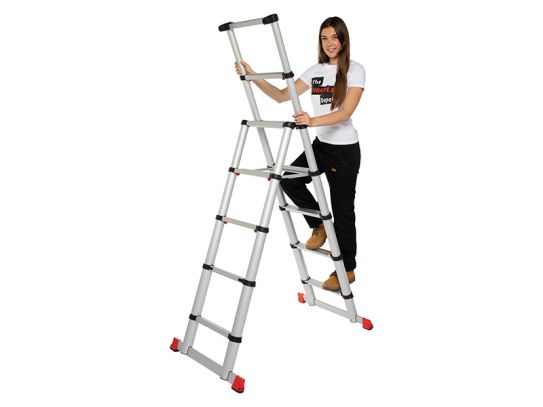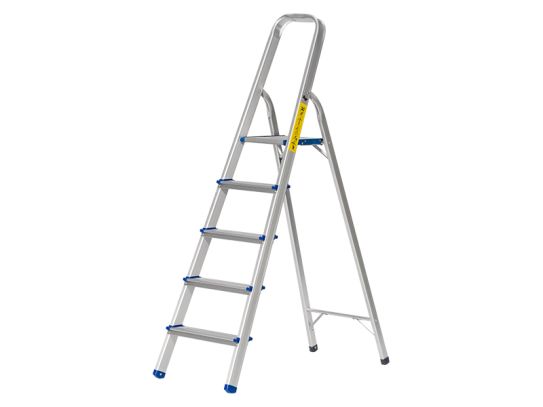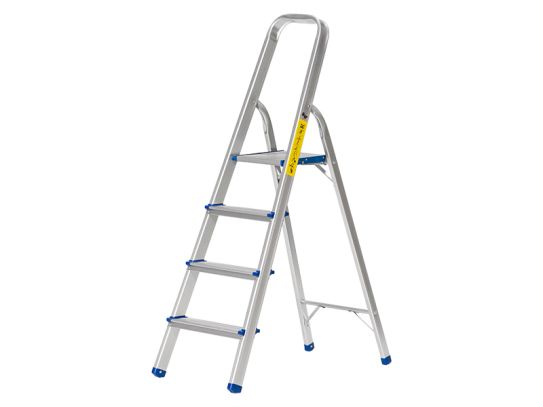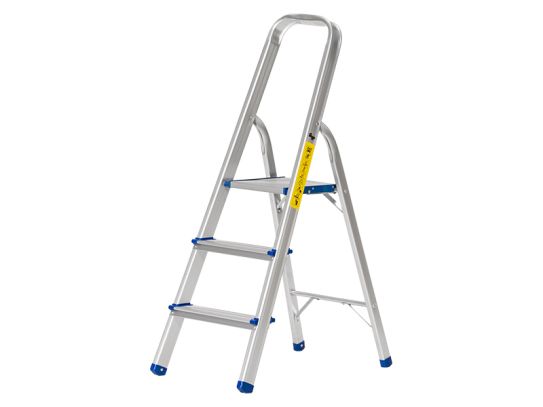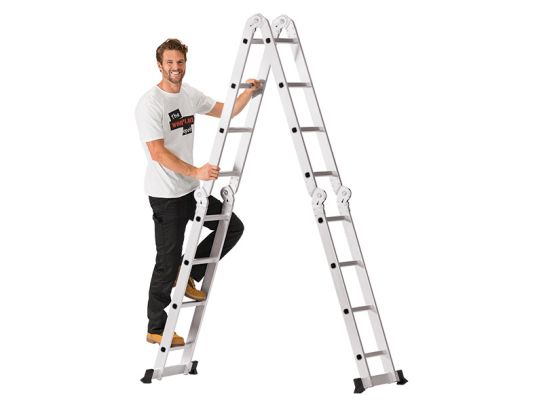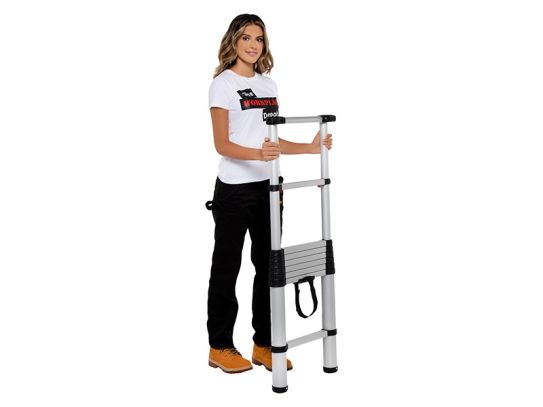Aluminium Step Ladders
Aluminium Step Ladders, Engineered for Safety and Durability
Step up to safety and convenience with our versatile range of aluminium step ladders. Whether you're a homeowner looking to tackle those hard-to-reach tasks, a professional in need of a sturdy and reliable ladder, or a handyman searching for a ladder that can do it all, we've got you covered. Our selection includes household ladders, folding ladders, platform ladders, combination ladders, work platforms, and extension ladders, all made from lightweight yet durable aluminium for easy transport and storage. Don't let a lack of equipment hold you back from getting the job done. Choose from our range of aluminium step ladders today!
What Are Aluminium Step Ladders?
Aluminium step ladders are ladders made of aluminium, a lightweight yet durable metal. They are used for a variety of tasks, including reaching high places in a household, work platform, commercial or industrial setting. They come in different types such as household ladders, folding ladders, platform ladders, combination ladders, work platforms, and extension ladders, each designed for specific purposes and tasks. They are typically lightweight, easy to transport and store, and can be adjusted to different heights. They may also have additional features such as non-slip feet, locking mechanisms, and safety locking bars.
What Are Some Common Uses for Aluminium Step Ladders?
Aluminium step ladders are used for a variety of tasks, including:
- Household tasks: such as changing light bulbs, cleaning gutters, and painting walls.
- Professional tasks: such as electrical work, maintenance work, and construction.
- Handyman tasks: such as DIY projects, home repairs, and landscaping.
- Industrial use: such as factory work, warehouse work, and maintenance tasks.
- Commercial use: such as retail store displays, restaurant kitchen, and office cleaning.
- Outdoor use: such as gardening, fishing and camping.
Many other tasks can be done with an aluminium step ladder, depending on the type of ladder you choose and how you use it.
What Are the Different Types of Aluminium Step Ladders?
There are several types of aluminium step ladders, each designed for specific purposes and tasks. These include:
- Household ladders: These are typically smaller, lightweight ladders that are intended for use around the home. They usually have a few steps and are suitable for tasks such as changing light bulbs or cleaning windows.
- Folding ladders: These are designed to be compact and easy to store. They can be folded up for easy transport and storage.
- Platform ladders: These have a platform or a tray at the top, which allows the user to stand on the ladder while working. They are ideal for tasks that require more stability and balance, such as painting or electrical work.
- Combination ladders: These are multi-purpose ladders that can be used as a step ladder, extension ladder, or scaffold. They are great for tasks that require different heights and can be transformed into different ladder types.
- Work platforms: These are similar to platform ladders but have a larger platform that can be used for a variety of tasks, such as electrical work, HVAC maintenance, and construction.
- Extension ladders: These are ladders that can be extended to reach higher heights. They are ideal for tasks such as cleaning gutters or reaching a higher roof.
These are some of the different types of aluminium step ladders available, and your choice will depend on the task you need to perform, safety and stability requirements.
What Are the Key Features to Consider When Choosing Aluminium Step Ladders?
When choosing an aluminium step ladder, some key features to consider include:
- Size and height: Consider the height of the ladder you need and ensure that it can be adjusted to the right height for your task.
- Weight capacity: Make sure the ladder can support the weight of the person who will be using it, and any tools or equipment that will be stored on it.
- Stability: Look for features such as non-slip feet or locking mechanisms to ensure the ladder is stable and secure when in use.
- Safety features: Look for safety features such as safety locking bars, which can help prevent the ladder from collapsing or slipping during use.
- Material: Aluminium is a common material for step ladders because it is lightweight and durable, but also consider the type of surface where the ladder will be used, if it could damage the surface or cause slips, such as rubber feet or non-marring tips.
- Portability: Consider how easy the ladder is to transport and store, particularly if you will be using it in different locations.
- Type of ladder: Different types of ladders are designed for different tasks, so consider the specific task you will be using the ladder for and choose the one that best suits your needs.
By considering all these factors, you can ensure that you are choosing a ladder that is safe, stable, and suitable for your needs.
What Are the Best Ways to Maintain and Store an Aluminium Step Ladder?
There are several ways to maintain and store an aluminium step ladder to ensure its longevity and safety:
- Clean the ladder regularly: Wipe down the ladder with a mild detergent and water to remove dirt and grime. This will also help to prevent rust and corrosion.
- Check for damage: Inspect the ladder for any damage, such as bent or broken rungs, and repair or replace any damaged parts.
- Lubricate moving parts: Lubricate any moving parts, such as hinges and locking mechanisms, to ensure they function smoothly and prevent rust.
- Store in a dry place: Store the ladder in a dry place, away from moisture and extreme temperatures. This will prevent rust and damage to the ladder.
- Store the ladder correctly: When storing the ladder, make sure it is stored in an upright position and that it is locked in place if it is a multi-position ladder.
- Safety check before use: Before each use, check the ladder for any damage or wear, making sure all the locking pins are in place and the ladder is stable.
- Don't overextend: Don't use the ladder on an extended height that is not recommended by the manufacturer.
- Use the right ladder: Use the right ladder for the task, using an extension ladder for height, a step ladder for stability, or a combination ladder for both.
By following these tips, you can ensure that your aluminium step ladder is well-maintained and stored correctly, making it safer and longer-lasting.
Are There Any Special Considerations for Using Aluminium Step Ladders Outdoors?
Yes, there are some special considerations when using aluminium step ladders outdoors:
- Weather conditions: Be aware of the weather conditions, such as wind and rain, which can make the ladder unstable. If the weather is bad, it's better to wait for a better day to use the ladder.
- Surface: Check the surface where you plan to set up the ladder. Make sure it is level, stable and dry to prevent slips and falls.
- Exposure to elements: Exposure to the elements can cause damage to the ladder over time, such as rust and corrosion. Make sure to clean and dry the ladder before storing it.
- UV rays: Aluminium is susceptible to UV rays, which can cause discolouration and weaken the material over time. Consider storing the ladder in a shaded area or covering it with a UV-resistant tarp when not in use.
- Insects and wildlife: Outdoor ladders are also exposed to insects and wildlife, which can damage the ladder. Check the ladder for any signs of damage before using it.
- Outdoor surface: Be aware of the surface you are using the ladder on, if it is slippery or uneven, consider using ladder levellers or slip-resistant shoes.
- Safety: Always follow safety guidelines and use the ladder correctly, regardless of whether you are using it indoors or outdoors.
By being mindful of these special considerations, you can ensure that you are using your aluminium step ladder safely and effectively when working outdoors.
Are There Any UK or European Industry Standards or Regulations That Apply to Aluminium Step Ladders?
Yes, there are industry standards and regulations that apply to aluminium step ladders in the UK and Europe.
In the UK, the ladder industry is regulated by the British Standards Institution (BSI) which sets standards for ladder design, construction and testing. Ladders that comply with these standards carry the BS EN 131 mark, which indicates that they have been tested and meet the required safety standards.
In Europe, ladders are regulated by the European Committee for Standardisation (CEN) and must comply with the EN 131 standard. This standard covers the safety requirements for portable ladders, including step ladders, and includes requirements for design, testing, and marking.
In addition to these standards, ladders must also comply with the Machinery Directive 2006/42/EC, which applies to all machinery used in the EU. This directive requires that ladders be designed and constructed in such a way as to minimise the risk of injury to users.
